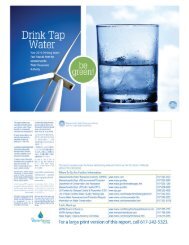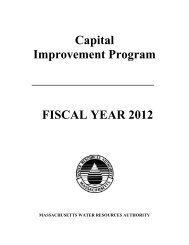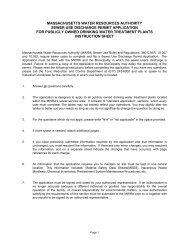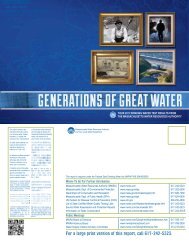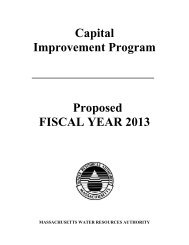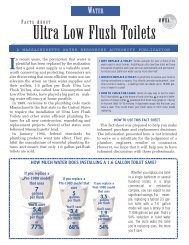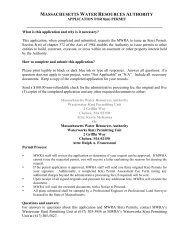2008 Report - Massachusetts Water Resources Authority
2008 Report - Massachusetts Water Resources Authority
2008 Report - Massachusetts Water Resources Authority
You also want an ePaper? Increase the reach of your titles
YUMPU automatically turns print PDFs into web optimized ePapers that Google loves.
Ms. Linda Murphy<br />
Director, Office of Ecosystem Protection<br />
U.S. Environmental Protection Agency New England<br />
P.O. Box 8127<br />
Boston, MA 02114<br />
Mr. Glenn Haas<br />
Director<br />
Division of <strong>Water</strong>shed Management<br />
Department of Environmental Protection<br />
One Winter Street<br />
Boston, MA 02108<br />
RE: <strong>Massachusetts</strong> <strong>Water</strong> <strong>Resources</strong> <strong>Authority</strong> Permit Number MA0103284<br />
Dear Ms. Murphy and Mr. Haas:<br />
August 22, <strong>2008</strong><br />
In compliance with the requirements of MWRA’s NPDES Permit MA0103284 - Part I, Item 10.c<br />
(page 14 of 32), please find enclosed: Summary <strong>Report</strong> of MWRA’s Demand Management<br />
Program for Fiscal Year <strong>2008</strong>.<br />
Should you require additional information, please contact Carl H. Leone, Senior Program<br />
Manager, Community Support Program at (617) 788-4356.<br />
Sincerely,<br />
Michael J. Hornbrook<br />
Chief Operating Officer<br />
cc: MA DEP, NERO<br />
MA DEP, Boston<br />
MA DEP, Worcester<br />
MA DEP, SERO<br />
Richard Chretien, MA DEP<br />
Grace Bigornia-Vitale, Sr. Program Manager, MWRA NPDES Compliance<br />
Carl H. Leone, Sr. Program Manager, MWRA Community Support Program
Summary <strong>Report</strong> of MWRA Demand Management Program<br />
Fiscal Year <strong>2008</strong><br />
This report is organized into four sections, as follows:<br />
1. Summary<br />
2. Background and Long Range <strong>Water</strong> Supply Program<br />
3. Ongoing Demand Management Programs and Detailed Activities during Fiscal Year <strong>2008</strong><br />
4. Demand Management Plans for Fiscal Year 2009<br />
1. Summary<br />
This report has been prepared to meet the requirements of the <strong>Massachusetts</strong> <strong>Water</strong> <strong>Resources</strong><br />
<strong>Authority</strong>’s (MWRA) NPDES Permit MA0103284 - Part I, Item 10.c (page 14 of 32). The purpose<br />
of the demand management section (including water conservation) in MWRA’s NPDES permit is to<br />
help maintain the dry day wastewater flow to the Deer Island Wastewater Treatment Plant below<br />
the 436 million gallons per day (mgd) permit limit. MWRA’s wastewater flow is derived from<br />
three flow components: sanitary flow, groundwater infiltration, and stormwater inflow. The demand<br />
management program will help reduce the sanitary component of wastewater flow as well as<br />
provide benefits to the water system and source watersheds. Information on reduction of infiltration<br />
and inflow is provided in the MWRA Annual Infiltration and Inflow Reduction <strong>Report</strong> for Fiscal<br />
Year <strong>2008</strong> (submitted under separate cover letter).<br />
MWRA has maintained the 365 calendar day running average dry day wastewater flow well below<br />
the 436 mgd limit and well below the 415 mgd trigger (see NPDES Permit Part I, Item 10.a and<br />
10.b). For fiscal year <strong>2008</strong> (ending June 30, <strong>2008</strong>), the 365-calendar day running average dry day<br />
flow to the Deer Island Wastewater Treatment Plant was 286.2 mgd; dry day flow has averaged<br />
about 320 mgd over the last nine years (see Table 1). The dry day flow is reported monthly by<br />
MWRA as part of the NPDES Operational Performance Summary.<br />
Table 1 – History of 365-Calendar Day Running Average Dry Day Wastewater Flow<br />
Fiscal Year Running dry day flow<br />
(mgd)<br />
2000 323.8<br />
2001 323.5<br />
2002 293.5<br />
2003 330.4<br />
2004 320.9<br />
2005 344.5<br />
2006 323.1<br />
2007 331.8<br />
<strong>2008</strong> 286.2<br />
Nine Year Average 320<br />
MWRA continues to implement effective water demand management policies and programs for the<br />
MWRA-owned distribution system, as well as member community-owned distribution systems. The<br />
1
following bullets provide an overview of actions take during FY08. Background information and<br />
details on each program are provided in other sections of this report.<br />
• Leak detection survey of 271 miles of MWRA distribution main and subsequent leak repairs,<br />
saving approximately 0.15 mgd of water;<br />
• Leak detection survey of 3,334 miles of member community distribution main in 21<br />
communities, and subsequent leak repairs, saving approximately 5.0 mgd of water;<br />
• $10 million in interest-free loans to fund 19 local community water pipeline rehabilitation<br />
projects, providing 13 miles of new water main and 12 miles of cleaned and lined water main;<br />
• Distribution of approximately 13,000 water saving fixtures (low-flow showerheads and faucet<br />
aerators), installation instructions and leak detection tablets are distributed with the low-flow<br />
fixtures;<br />
• Distribution of over 480,000 pieces of water conservation literature; and<br />
• 365 classroom presentations reaching more than 10,000 students in the service area.<br />
The continued effectiveness of MWRA’s conservation efforts over the past year is demonstrated by<br />
the fact that baseline water demand (water withdrawal from MWRA reservoirs) continues to remain<br />
stable or decline and is comfortably below the system’s safe yield of 300 mgd as shown on Figure 1<br />
(for additional detail, see notes under Table 2).<br />
MGD<br />
350<br />
300<br />
250<br />
200<br />
150<br />
100<br />
MWRA 5-Year Average System Demand<br />
1950 1960 1970 1980 1990 2000<br />
2<br />
5-yr Moving Average<br />
Safe Yield<br />
MWRA Established<br />
Figure 1 – MWRA Reservoir Withdrawals<br />
For calendar year 2007, water demand was 219.9 mgd. Table 2 provides data on water use and<br />
wastewater generation over the most recent ten-year period (calendar year data). The data on “water<br />
demand” represents total water withdrawals from MWRA reservoirs. The data on “wholesale water
sales” represents water provided by MWRA to all 50 fully and partially supplied communities (a<br />
population of about 2.3 million). “Total wastewater generation” data represents the total flow to the<br />
Deer Island Treatment Facility from all 43-member sewer communities (a sewered population of<br />
about 2.0 million). The “dry day wastewater generation” data represents flow to the Deer Island<br />
Treatment Facility during only dry days as defined in MWRA’s NPDES Permit.<br />
Calendar<br />
Year<br />
Table 2 – MWRA Total <strong>Water</strong> Demand and Wastewater Generation<br />
<strong>Water</strong><br />
Demand<br />
(Withdrawals)<br />
Wholesale<br />
<strong>Water</strong><br />
Sales<br />
3<br />
Total Wastewater<br />
Generation<br />
Dry Day<br />
Wastewater<br />
Generation<br />
1998 260 mgd 231 mgd 412 mgd N/A<br />
1999 276 mgd * 245 mgd* 344 mgd 307 mgd<br />
2000 252 mgd * 229 mgd* 362 mgd 331 mgd<br />
2001 247 mgd * 229 mgd* 346 mgd 305 mgd<br />
2002 237 mgd 219 mgd 340 mgd 309 mgd<br />
2003 222 mgd** 214 mgd 382 mgd 333 mgd<br />
2004 216 mgd** 208 mgd 356 mgd 327 mgd<br />
2005 225 mgd** 213 mgd 403 mgd 342 mgd<br />
2006 212 mgd 201 mgd 380 mgd 322 mgd<br />
2007 220 mgd 209 mgd 330 mgd 300 mgd<br />
10 Year Average 237 mgd 220 mgd 366 mgd 320 mgd<br />
* Total withdrawals and water sales included an additional (temporary) demand from Cambridge while it rebuilt its<br />
own water treatment plant. For calendar year 1999, 15 mgd; calendar year 2000, 14 mgd; and calendar year 2001, 6<br />
mgd. ** Total withdrawals do not include an additional demand associated with Carroll <strong>Water</strong> Treatment Plant start<br />
up and testing activities. For calendar year 2003, 2,710 MG (annual average 7.4 mgd); calendar year 2004, 1,326 MG<br />
(annual average 3.6 mgd); calendar year 2005, 12,264 MG (annual average 33.6 mgd).<br />
Considerable additional data on MWRA demand management and water conservation programs can<br />
be found on MWRA’s website at www.mwra.com.<br />
2. Background and Long Range <strong>Water</strong> Supply Program<br />
The MWRA, an independent public authority, was established through legislation in 1985 to<br />
provide wholesale water and sewer services to 2.5 million people in 61 cities and towns. Some of<br />
the <strong>Authority</strong>’s goals, purposes and objectives relate directly to water demand management efforts,<br />
including:<br />
• Efficient and economical operation of water delivery;<br />
• Programs for leak detection for member communities; and,<br />
• Repair, replacement, rehabilitation, modernization and extension of the delivery of water<br />
within the service area of the <strong>Authority</strong>.<br />
From its inception, MWRA has made demand management/water conservation a high priority. In<br />
1985, MWRA inherited a water system that had been exceeding its safe yield of 300 mgd for almost<br />
twenty years. In response to increasing water demand during the 60s, 70s and 80s, several water<br />
supply studies were undertaken by MWRA’s predecessor agency, the Metropolitan District<br />
Commission (MDC). These studies, collectively called the Long Range <strong>Water</strong> Supply Study-EIR<br />
2020, projected the need for 70 mgd of additional supply by 2020 above a base demand of 340 mgd.
The studies identified a series of supply development options including diversion of a portion of the<br />
Connecticut River flow. Demand management options were also examined. In 1986, the MWRA<br />
Board of Directors, through a series of water policy decisions, opted to aggressively pursue demand<br />
management strategies rather than pursue options for increasing water supply. This commitment to<br />
demand management resulted in the implementation of a highly successful water conservation<br />
program that has been a role model for water conservation efforts both nationally and globally.<br />
Long Range <strong>Water</strong> Supply Program<br />
Following the commitment by the Board of Directors in 1986 to demand management, MWRA in<br />
1987 developed and launched its Long Range <strong>Water</strong> Supply Program (LRWSP). The LRWSP<br />
included 30 different recommendations to be completed over the next decade at a cost of tens of<br />
millions of dollars. The demand management components of the LRWSP were meant to reduce<br />
water use and water losses throughout the service area. During a three-year trial program from<br />
1987-1989, MWRA, along with its member communities, initiated demand management efforts that<br />
reduced average demand from 326 mgd in 1987 to 285 mgd in 1990 (see Figure 1). This reduction<br />
put average demand below the water system’s safe yield of 300 mgd for the first time in over 20<br />
years. With this success, the demand management components of the LRWSP were continued<br />
beyond the trial program. A detailed discussion of the demand management activities developed<br />
from the LRWSP, covering the 1991 through 2000 period, was provided in the Fiscal Year 2000<br />
MWRA Demand Management <strong>Report</strong> (available at www.mwra.state.ma.us/harbor/enquad/pdf/ms-<br />
061.pdf).<br />
Drought Management Plan<br />
In addition to long range planning, the need for a short term drought management plan was made<br />
clear after two years of below average precipitation and overuse of the Quabbin-Ware-Wachusett<br />
system led to a potential drought warning in the 1988-1989 period. The MWRA Drought<br />
Management Plan was submitted to the <strong>Massachusetts</strong> Department of Environmental Protection in<br />
1989. Shortly thereafter, precipitation returned to normal and the reservoirs rose back to normal. In<br />
spring 2000, MWRA was involved in the <strong>Massachusetts</strong> Drought Management Task Force’s<br />
development of a state drought response plan. The plan outlines agency responsibilities during<br />
drought and sets drought stage triggers based on hydrologic conditions. The plan is regionally<br />
flexible; for example, small water systems may need water use restrictions during a short-term<br />
drought while the MWRA service area would avoid restrictions due to the large storage volumes in<br />
Wachusett and Quabbin Reservoirs. Only a long-term drought more severe than the 1960’s drought<br />
of record would lead to restrictions in the MWRA service area. The plan also retains<br />
responsibilities for MWRA’s direct lines of communication with member communities and<br />
customers during a drought.<br />
3. Ongoing MWRA Demand Management Programs and Activities During<br />
Fiscal Year <strong>2008</strong><br />
Planning and Policies<br />
In January 2007, MWRA completed an updated <strong>Water</strong> System Master Plan which is intended to<br />
serve as the framework for annual capital planning and budgeting decisions. As part of this effort,<br />
4
staff documented supply and demand characteristics of the system to confirm that the 300 mgd safe<br />
yield of the MWRA water system is sufficient to meet future demand for water both within the<br />
service area and additional demand outside the service area as may be approved. Staff used the<br />
following conservative demand planning scenario to arrive at this conclusion: continuation of<br />
current base demand in the existing MWRA service area (230 mgd, based on 5-year average<br />
demand in FY2004); projected increased demand from population and employment growth through<br />
2030 within the existing MWRA service area (13 mgd); approximately 5 mgd from new<br />
communities that were actively pursuing admission or increased withdrawals from MWRA in<br />
2007; an allowance for the potential additional demand for MWRA water from partially served<br />
communities (planning assumption is up to 18 mgd); and potential additional demand for MWRA<br />
water from as many as 22 communities not currently or actively pursuing MWRA admission but<br />
within proximity to the service area and that may have or face future water deficits (up to 10 mgd).<br />
The conservative planning scenario represents a potential future demand of 276 mgd, well below<br />
the system safe yield of 300 mgd.<br />
MWRA has adopted Policies that establish stringent controls and a rigorous approval process for<br />
entities seeking admission to the MWRA water system or to use MWRA water on an emergency<br />
basis. These policies include:<br />
• OP.05, Emergency <strong>Water</strong> Supply Withdrawals. This policy applies to communities outside<br />
MWRA's water service area that are seeking water on an emergency basis. The MWRA may<br />
approve emergency withdrawals for no more than six months at a time.<br />
• OP.09, <strong>Water</strong> Connections Serving Property Partially Located in a Non-MWRA<br />
Community, also referred to as the "<strong>Water</strong> Straddle" policy. This policy applies to all parties<br />
seeking to obtain water for a location, building, or structure situated entirely outside the MWRA<br />
water service area but located on a parcel of land, under single ownership, and which is subject<br />
to an integrated plan for use or development, that is partly inside the MWRA's water service<br />
area.<br />
• OP.10, Admission of New Community to MWRA <strong>Water</strong> System. This policy applies to<br />
communities seeking admission to the MWRA water system, and to state, county, institutional,<br />
and federal facilities seeking MWRA water for a location outside MWRA's water service area,<br />
as defined in MWRA's Enabling Act.<br />
Demand management is also an important component of regulations for MWRA’s Continuation of<br />
Contract <strong>Water</strong> Supply (360 CMR 11.00) that is applicable to 24 communities that purchase water<br />
from the <strong>Authority</strong> under a cooperative contract basis. In addition, all communities that purchase<br />
water from MWRA are required to complete a leak detection survey and perform follow-up leak<br />
repairs of their entire distribution system at least once every two years (360 CMR 12.00).<br />
Leak Detection and Repair of MWRA Distribution System<br />
The MWRA annual leak detection and repair program (initially established during 1988 to 1990) is<br />
performed by MWRA personnel. All MWRA water distribution pipes (284 miles) are surveyed on<br />
a regular maintenance schedule for leaks with repairs made promptly. During FY08, a total of<br />
271.6 miles of MWRA-owned distribution main were surveyed for leaks. A total of 3 leaks were<br />
5
detected and repaired, accounting for approximately 0.2 mgd of water savings. Table 3 shows the<br />
history of the last nine years of leak detection on MWRA distribution system.<br />
Table 3 – Leak Detection on MWRA Distribution System<br />
Period Miles Surveyed Number of leaks Estimated leakage-mgd<br />
FY00 260 17 0.4<br />
FY01 267 13 0.5<br />
FY02 257 13 0.5<br />
FY03 230 26 1.0<br />
FY04 184 16 0.5<br />
FY05 227 19 0.6<br />
FY06 270 10 0.6<br />
FY07 258 16 0.4<br />
FY08 272 3 0.2<br />
9 Year Average 247 15 0.5<br />
MWRA Capital Projects from the 2007 <strong>Water</strong> Master Plan<br />
Total water system needs identified for the FY07- 48 Master Plan timeframe are approximately $1.1<br />
billion (in current dollars) including projects already in the CIP. The Master Plan is based on the<br />
following major assumptions and findings:<br />
• The 300 mgd safe yield of the MWRA water system is sufficient to meet future demand for<br />
water both within the service area and additional demand outside the service area as may be<br />
approved.<br />
• There is adequate treatment plant capacity, and generally adequate transmission capacity<br />
under normal operations to meet MWRA system needs under the demand planning scenario.<br />
Distribution capacity is generally adequate with the exception of a few weak spots addressed<br />
in either the Master Plan or existing CIP.<br />
• MWRA’s transmission system lacks redundancy in some key areas; a proposed redundancy<br />
study will identify potential solutions and help to prioritize major expenditures.<br />
• Areas within the distribution system without adequate redundancy were targeted in the<br />
Master Plan and initial studies are now underway to address these deficiencies. These<br />
studies are focused on the Northern Intermediate High and Southern Extra High pressure<br />
zones.<br />
• MWRA falls short of its goal of distribution storage sufficient to meet one day of demand.<br />
The Master Plan recommends addressing the system’s highest risk areas. Again, initial<br />
focus is on the Northern Intermediate High and Southern Extra High pressure zones for<br />
opportunities to increase distribution storage in these areas.<br />
6
• No new design and construction funds are included to address the impacts of potential<br />
changes in federal or state regulations. The FY08 CIP already includes funds to meet the<br />
requirements of the Long Term 2 Enhanced Surface <strong>Water</strong> Treatment Rule.<br />
• Continuation of MWRA’s ongoing program to systematically replace old, cast iron water<br />
mains is recommended for continued water quality improvements. This work is also<br />
consistent with EPA’s anticipated direction on distribution system regulation. To date,<br />
MWRA has lined 38 miles of old cast iron main with approximately 90 additional miles of<br />
main identified for rehabilitation or replacement in either the CIP or 2007 Master Plan.<br />
All of the projects identified in the Master Plan were prioritized and, as a result, much of the work<br />
noted above has been incorporated into the Final FY09 CIP and MWRA anticipates an ongoing<br />
process to review and update this information.<br />
Leak Detection and Repair of Member Community Distribution Systems<br />
To help communities identify leaks in their local distribution systems, a program providing a free<br />
one-time leak detection survey was establish during 1988 to 1990. Based on the success of the<br />
initial program, MWRA developed leak detection regulations (360 CMR 12.00) that went into<br />
effect in July 1991. Communities that purchase water from MWRA are required to complete a leak<br />
detection survey of their entire distribution system at least once every two years. Communities can<br />
accomplish the survey in one of three ways: (1) using their own crews, (2) hiring their own<br />
contractor, or (3) using MWRA’s task order leak detection services contract. Leak detection/repair<br />
work is generally cost effective as the value of the saved water often far exceeds the cost of the leak<br />
detection/repair work. During FY08, a total of 3,334 miles of local water pipeline were surveyed<br />
for leaks. A total of 458 leaks were detected and repaired in 21 community distribution systems,<br />
accounting for 5.0 mgd of water savings. Table 4 shows the history of the last seventeen years of<br />
leak detection on community pipes.<br />
Table 4 - Leak Detection on Community Pipes<br />
Period Miles Surveyed Number of leaks Estimated leakage-mgd<br />
FY92 & FY93 6227 1988 24.8<br />
FY94 & FY95 5924 1134 14.1<br />
FY96 & FY97 6013 1527 17.8<br />
FY98 & FY99 5924 1257 12.4<br />
FY00 & FY01 6650 928 9.3<br />
FY02 & FY03 6198 1032 8.6<br />
FY04 & FY05 6753 968 13.2<br />
FY06 & FY07 6871 833 8.5<br />
FY08 3334 458 5.0<br />
17 Year Average 3170 596 6.7<br />
7
Rehabilitation and Replacement of Member Community Distribution Systems<br />
MWRA implemented the pilot <strong>Water</strong> Infrastructure Rehabilitation Financial Assistance Program in<br />
1997-1999. This program provided $30 million in 25 percent grants and 75 percent interest-free<br />
loans to member water communities for water system rehabilitation projects. Local projects<br />
implemented through this program resulted in the replacement of over 22,000 water meters and<br />
rehabilitation or replacement of over 80 miles of distribution pipeline. <strong>Water</strong> loss from both<br />
pipeline and valve leakage was reduced.<br />
In November 1999, MWRA approved the $256 million Local Pipeline Assistance Program (LPAP)<br />
established with the primary objective of improving water quality in community-owned distribution<br />
systems. This interest-free loan program primarily funds replacement and/or cleaning/lining of<br />
unlined watermains. A secondary benefit of the program is the reduction of water pipeline leakage.<br />
Quarterly funding distribution under the Local Pipeline Assistance Program began in August 2000<br />
(FY01). Through eight years of the program, $140 million has been distributed to twenty-nine<br />
communities to fund 176 local projects. These projects have provided for a total of 135 miles of<br />
new lined water pipe and 86 miles of cleaning and lining of existing water pipe. Table 5 shows the<br />
history of the Pilot and Local Pipeline Assistance Programs.<br />
Table 5 – Summary of Pilot and LPAP Programs<br />
Period $ Distributed Projects Funded<br />
8<br />
Miles of New<br />
Pipe<br />
Miles of Rehabilitated<br />
Pipe<br />
FY98/99 $30 million 85 42 39<br />
FY01 $17 million 32 18 22<br />
FY02 $16 million 19 22 6<br />
FY03 $16 million 18 16 9<br />
FY04 $19 million 22 24 4<br />
FY05 $20 million 24 17 15<br />
FY06 $17 million 17 7 4<br />
FY07 $26 million 25 18 14<br />
FY08 $10 million 19 13 12<br />
TOTAL $170 million 261 177 125<br />
<strong>Water</strong> Metering and Monitoring<br />
Continued annual routine calibration and maintenance of the revenue meters allows MWRA to track<br />
water use and accurately charge its wholesale customer communities. MWRA analyzes nighttime<br />
low flow data and historical trends from the revenue meters to help member communities identify<br />
potential water leakage in local systems. During FY08, MWRA continued its ongoing program for<br />
operation and maintenance of the water metering system. All meters received routine calibration on<br />
a regular schedule.
Residential <strong>Water</strong> Conservation<br />
MWRA continues to provide low-flow device kits to member communities, housing authorities,<br />
development corporations, and individual retail customers at no cost. The low-flow device kits<br />
include: 2.0 gallon per minute (gpm) showerheads, 1.5 gpm bathroom faucet aerators, 2.2 gpm<br />
kitchen faucet aerators, fixture installation instructions, and leak detection dye tablets. MWRA also<br />
maintains its water conservation hotline (617-242-SAVE). During FY08, a total of 12,998 water<br />
saving fixtures (4,365 showerheads, 8,633 faucet aerators) were distributed to MWRA households<br />
and member community water departments.<br />
Public Education Outreach<br />
MWRA continues to provide public education material to communities and individual customers at<br />
no cost. Member communities are encouraged to distribute the water conservation information to<br />
retail customers (usually distributed as a bill insert). The primary information targeted for retail<br />
customers is indoor and outdoor water conservation brochures printed/folded to be used by member<br />
communities as bill inserts. MWRA also provides the brochures directly to retail customers,<br />
watershed associations, environmental groups, etc. to fulfill e-mail and telephone requests.<br />
During FY08, MWRA sent letters and follow-up e-mails to all water and sewer member<br />
communities highlighting the <strong>Authority</strong>’s bill insert educational brochures on indoor and outdoor<br />
water conservation, and outlining the availability (at no cost) of the water conservation kits.<br />
Seventy percent of the member communities took advantage of this offer. In all, over 480,000<br />
pieces of printed materials were distributed.<br />
During FY08, MWRA teamed with the US EPA to become a <strong>Water</strong>Sense program partner to help<br />
consumers save water for future generations and reduce costs on their utility bills. <strong>Water</strong>Sense<br />
aims to decrease indoor and outdoor water use through water-efficient products and simple watersaving<br />
practices. The program encourages customers to look for <strong>Water</strong>Sense labeled products,<br />
which have been independently certified for efficiency and performance, and promotes watersaving<br />
techniques that reduce stress on water systems and the environment.<br />
During FY08, MWRA expanded its water conservation information included in the 2007 Annual<br />
Drinking <strong>Water</strong> Quality <strong>Report</strong>. This report is mailed to every household in the MWRA service<br />
area, a distribution of more than 800,000. The Annual <strong>Water</strong> Quality <strong>Report</strong> also caries the EPA<br />
<strong>Water</strong>Sense Partner logo.<br />
School Education<br />
MWRA continues to promote water conservation awareness for young people. The ongoing School<br />
Education program is designed to provide a science-based curriculum using a four step process:<br />
educational curriculum development, conducting classroom presentations, wide-spread teacher<br />
training and continual follow-up, and support to educators. Educational materials have been<br />
designed for students from the elementary level to the high school level. During the FY08<br />
(2007/<strong>2008</strong>) school year, MWRA’s School Educational outreach program (including water<br />
conservation information) made 365 classroom presentations reaching more than 10,000 students in<br />
pre-kindergarten through college level classes in 45 communities. In addition to classroom<br />
presentations, the MWRA again held a Poster/Writing Contest. More than 2,000 posters and writing<br />
9
entries were submitted. The poster contest topic for all three writing categories (grades K-2; grades<br />
3-5 and grades 6-8) was tap vs. bottled water.<br />
Industrial, Commercial, and Institutional Audits and New Technologies<br />
MWRA has found that conservation initiatives for industrial, commercial, and institutional water<br />
users are widely available through private consulting firms. MWRA has developed and offers at no<br />
cost a 52-page Guide To <strong>Water</strong> Management that contains detailed information to help local facility<br />
managers reduce overall water use. In addition, detailed fact sheets on industrial, commercial, and<br />
institutional water users are available at MWRA’s web site at<br />
http://www.mwra.com/04water/html/indust.htm. These include specifics on hospitals, schools,<br />
colleges and athletic facilities; restaurants; and commercial buildings.<br />
<strong>Water</strong> Supply Citizens Advisory Committee<br />
MWRA’s 1986 decision to aggressively pursue water conservation rather than look for additional<br />
sources of water was strongly advocated by the <strong>Water</strong> Supply Citizens Advisory Committee<br />
(WSCAC). This unique citizen’s group was formed in 1977 to review a proposed Connecticut<br />
River diversion plan to supply water to the metropolitan Boston area. From its beginning, the group<br />
has been a strong supporter of water conservation measures. It helped formulate the water<br />
conservation language in MWRA’s Enabling Act legislation. In 1986, WSCAC encouraged<br />
MWRA to pursue demand management rather than look for new water supplies. During the late<br />
1980’s and early 1990’s, the citizen’s group took a lead role promoting trigger and drought<br />
management planning. With its long commitment to the water supply system, WSCAC continues<br />
to provide independent citizen input on MWRA’s policies and programs, while voicing public<br />
support of source protection and conservation. During FY08, the <strong>Water</strong> Supply Citizens Advisory<br />
Committee has continued to strongly support MWRA’s water conservation efforts. The committee<br />
has been active providing review and input on water system expansion issues. A two-year contract<br />
for continuation of WSCAC was authorized by the MWRA Board of Directors on June 6, 2007.<br />
Other Activities<br />
In addition to the activities outlined above, MWRA staff have provided assistance to outside<br />
agencies in the area of water conservation. In celebration of Earth Day, MWRA provided water<br />
conservation fixtures and literature for EPA’s Green Expo, Chicopee’s GreenFest, and Needham<br />
Technology Center’s celebration. Also, staff provided water conservation fixtures and literature to<br />
promote water conservation for: Celebrate Milton Day, A Science Fair at The Amigo’s School in<br />
Cambridge and Boston’s West End Civic Association Festival.<br />
4. Demand Management Plans for Fiscal Year 2009<br />
During FY09, MWRA plans to continue its demand management efforts at a similar level as FY08.<br />
The <strong>Authority</strong>’s long-range planning, leak detection, system rehabilitation, water conservation and<br />
educational outreach programs have long been established as essential components of demand<br />
management. MWRA’s Community Support Program will continue to work with both water and<br />
sewer member communities to foster water conservation activities and help minimize wastewater<br />
flow.<br />
10
During FY08, MWRA applied for and received an $80,000 grant to initiate two new community<br />
based water conservation programs. One is a community water audit pilot project (two<br />
communities) to balance the volume of water purchased from MWRA (wholesale purchase) with<br />
the volume billed (retail sales) and account for the remainder of non-billed water volume. The<br />
second is a direct incentive program to promote water member communities to purchase/install low<br />
flow (1.6 gallon per flush or less) toilets in public buildings. The direct incentive will be provided<br />
via a $100 rebate for purchase/installation of a low flow toilet that replaces an older, less efficient<br />
toilet using a larger water volume per flush.<br />
11




